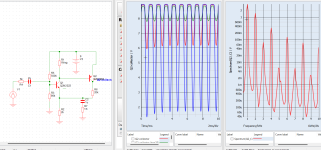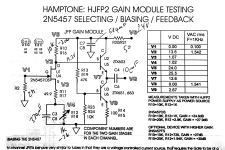Peter, Paul, and Mary had some good recordings. Simpler music like folk did better on the equipment at the time.
Ed
Ed
Power JFETs can be used in a preamp circuit or power amplifier circuit to produce nice harmonic distortion profiles similar to that of triode tubes. The operating points can be adjusted to obtain the magnitude (and orders) of harmonic distortion desired. These circuits can be quite simple. UnitedSic has power JFETs in current production and Lovoltech power JFETs are still available cheap.
If someone wants to pay more (still cheaper than 300B tubes), there are Sony VFETs and Tokin SITs which have triode-like characteristics as well.
If someone wants to pay more (still cheaper than 300B tubes), there are Sony VFETs and Tokin SITs which have triode-like characteristics as well.
For @Giri to have control of all the parameters he/she wants, I think a multi effekt processor is the way to go.
@Giri will you use in a loop between preamp and poweramp?
Or does your source have digital output, so the signal can be kept digital through multieffect and till after your dac?
Have you looked on Behringers homepage? They keep popular models for a very long time so be aware that you don't buy a 30 year old model.
Peavey bought a (Swedish?) company that modelled electronics to emulate all kinds of amplifiers. Peavey put it in their guitar amps but maybe it was made as stand alone. Sorry I dont remember its name. They sell/sold it at a PC program/plugin too.
Cheers!
@Giri will you use in a loop between preamp and poweramp?
Or does your source have digital output, so the signal can be kept digital through multieffect and till after your dac?
Have you looked on Behringers homepage? They keep popular models for a very long time so be aware that you don't buy a 30 year old model.
Peavey bought a (Swedish?) company that modelled electronics to emulate all kinds of amplifiers. Peavey put it in their guitar amps but maybe it was made as stand alone. Sorry I dont remember its name. They sell/sold it at a PC program/plugin too.
Cheers!
Jfet Q1是在极低电流下工作的高阻抗输入级。Q2和Q3通过R6和R7向源提供输出和反馈。D1、R7和R8在二次谐波产生的过零点附近提供了圆形削波。R7的值决定削波的积极程度。没有限幅网络时,放大器增益为(R6/R1)+1,失真约为0.05%,对于吉他和麦克风应用来说已经足够好了
 Translated:
Translated:Jfet Q1 is a high impedance input stage operating at very low current. Q2 and Q3 provide output and feedback to the source through R6 and R7. D1, R7, and R8 provide circular clipping near the zero-crossing point where the second harmonic occurs. The value of R7 determines how aggressively the clipping is. Without the limiting network, the amplifier gain is (R6/R1) 1 and the distortion is about 0.05, which is good enough for guitar and microphone applications.
Last edited by a moderator:
+1How about korg nutube pre. No simulation. Tube sound, no hassle.
One possibly significant aspect is the thermal stability. I used to think "bad sounding 0.0000x% THD" was just folklore, but now I see it's probably real. DSP with triode curves won't fix issues in the analogue design, like driver BJTs swinging too much power, where the heat dissipated in the junction modulates the gain parameters, causing hidden IMD that totally bypasses the simulator's THD estimates.
Unless you force the simulator to include dynamic heating effects, which nobody ever does.
Remove R4 and R5 and check differential voltage VGS of J113 -- DC bias should be about 1.27V Output DC bias should be 5.27VWhy can't I see the wave pattern at the output?View attachment 1296349View attachment 1296350
Hamptone circuit produces 2nd harmonic mostly and is considered tube-like sounding. Based on input jfet and bypass cap, one can have any amount of distortion from 0.02% to 0.6%.
https://www.diyaudio.com/community/threads/hamptone.405097/page-2
https://www.diyaudio.com/community/threads/hamptone.405097/page-2
Attachments
Interesting - try in simulation tomorrow
Looks like overdriving a common source Jfet at higher gain setting . U5 is a follower and U6 constant current source load. ZTX are big BJTs -- hefty output
Looks like overdriving a common source Jfet at higher gain setting . U5 is a follower and U6 constant current source load. ZTX are big BJTs -- hefty output
Excellent circuit! Did not include BJTs as they are just follower -- but a very good linear follower.

To much tubey sound can be mushy.
However a properly biased twin triode setup produces little distortion but does great things to the sound.
I am also using a tube preamp into a SS amp. (0.003% thd) . At low volume 0.01 watt the sound is fantastic. The distortion does not become visible on the scope till > 80w.
The Jfet may sound good but it is way to exaggerated.
However a properly biased twin triode setup produces little distortion but does great things to the sound.
I am also using a tube preamp into a SS amp. (0.003% thd) . At low volume 0.01 watt the sound is fantastic. The distortion does not become visible on the scope till > 80w.
The Jfet may sound good but it is way to exaggerated.
Just want wanted to see how harmonics are at high overdrive for guitar -- can easily be adjusted back. That circuit gives distortion on saturation side of Jfet.
I tried putting distortion on pinch off side and looks really clean -- high order harmonics greatly suppressed which is good. Also -- just checking range side adjusted high . Easy enough to build and try on Les Paul later

I tried putting distortion on pinch off side and looks really clean -- high order harmonics greatly suppressed which is good. Also -- just checking range side adjusted high . Easy enough to build and try on Les Paul later
Vibrating string creates asymmetrical waveforms as is.
The player has constant control of one heck of a complicated waveform.
But the second harmonic is very strong already with string instruments.
So the amplifier pre and post.
" tube magic second" is not very special for guitar.
But yes , pretty basic transistor circuits can make plenty
of 2nd harmonic.
Far as clipping / saturation / distortion
most the magic is pre and post filtering.
The player has constant control of one heck of a complicated waveform.
But the second harmonic is very strong already with string instruments.
So the amplifier pre and post.
" tube magic second" is not very special for guitar.
But yes , pretty basic transistor circuits can make plenty
of 2nd harmonic.
Far as clipping / saturation / distortion
most the magic is pre and post filtering.
- Home
- Source & Line
- Digital Line Level
- Looking for tube sound goodness without tube hassle

